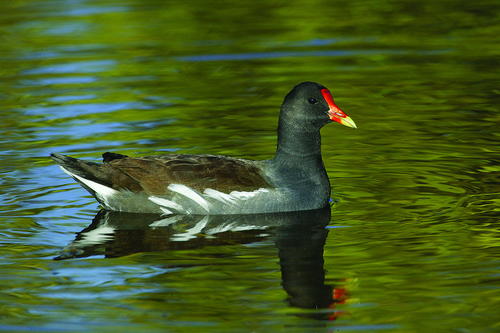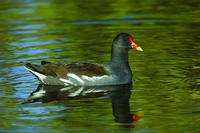Big Rails
The coots and gallinules don't looks or act much like their smaller cousins.

Coots and their kin belong to an old family. Fossils of these birds reveal that they were on the North American scene 2.5 million years ago, about the time when the first members of the human line were taking their first tentative steps in other parts of the world.
But the American coot and its relatives the common and purple gallinules are not a family unto themselves. In fact, they are members of the Raillidae family, the group of birds that includes the secretive clapper, king, sora, and yellow rails—birds whose secretive behavior makes them difficult to find even under ideal conditions. And these largest rails often don’t even act like rails. Instead of slinking through the undergrowth or tiptoeing through the fallen grasses and sedges of the marshlands, American coots (Fulica americana) gather in flocks and use their lobed toes to swim in open water on lakes and rivers, acting more like ducks than rails. Purple gallinules (Porphyrio martinicus) and common gallinules (Gallinula galeata), on the other hand, walk on mats of floating vegetation for the entire world to see, peeking under floating leaves for tender morsels of food.
Incidentally, the Latinate term “gallinule” literally means “chicken.” Apparently, the people who named these birds thought they resembled barnyard chickens as they slithered through vegetation, jerking their heads with each movement. Even though considered game birds, it is doubtful that the gallinules taste like chicken. Reports over the years have described their flesh as “gamey,” “fishy,” “horrid,” and worse. Maybe it is an acquired taste—ancient middens filled with thousands of coot and gallinule bones indicate that at one time Native Americans harvested these birds in huge numbers for gatherings and feasts.
The American coot and the common and purple gallinules may appear similar but they have some notable differences. The gallinules have laterally compressed bodies, helping them slink through the reeds and cattails and glide through the undergrowth like ships on a sea, just as their smaller rail cousins slink duck-like, an adaptation to the open waters that they favor. All these birds have strong legs with long toes that can firmly grip shrubs and branches. The toes fold together like an artist’s easel to allow easy movement through heavy brush. The coots’ toes are similar but have additional lobes that also make them excellent for swimming. Coots and gallinules all have a forehead shield that is a rarity in the bird world. They are also large, at least when compared to rails, often the same size as the ducks that share their waterways.
Read the rest of his article in Wildfowl Carving Magazine’s Summer 2013 issue.
Read NextBig Whoop



